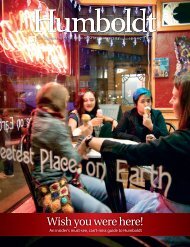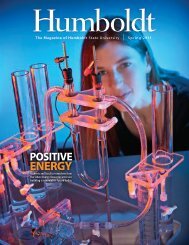Unveiled - Humboldt Magazine - Humboldt State University
Unveiled - Humboldt Magazine - Humboldt State University
Unveiled - Humboldt Magazine - Humboldt State University
You also want an ePaper? Increase the reach of your titles
YUMPU automatically turns print PDFs into web optimized ePapers that Google loves.
“A man for others”<br />
SEAN MCCARTNEY’S JOURNEY TO the island nation of<br />
Madagascar began on a recumbent bicycle at <strong>Humboldt</strong> <strong>State</strong>,<br />
where he volunteered to collect recyclable material as part<br />
of the campus recycling program.<br />
“I was raised to be, pardon the expression, a man for others,”<br />
McCartney says. “At HSU, the people that inspired me the most<br />
were the ones who<br />
were actually trying<br />
to give back to the<br />
community.”<br />
On hearing<br />
from friends who<br />
had served in the<br />
Peace Corps, Mc-<br />
Cartney became<br />
convinced it was<br />
the right vehicle for<br />
his energies. “The<br />
more I looked into<br />
the Peace Corps,<br />
the more it seemed<br />
a logical progression<br />
– to volunteer,<br />
get life experience<br />
and world travel,”<br />
he says.<br />
After he earned<br />
his geography degree<br />
in 2004, he<br />
set out for the<br />
remote village of<br />
Miadampahonina.<br />
Natives of the subtropical<br />
highlands<br />
cultivate rice as their principal crop, produced in a timehardened<br />
traditional manner. McCartney jumped in with<br />
both feet and quickly realized that learning the local dialect<br />
was crucial. After months of struggle, there was a turning<br />
point when McCartney knew he’d mastered Malagasy.<br />
“Until you can make a joke in that language, you’re not<br />
going to understand the majority of what’s being said,” he<br />
notes. “To actually make a joke that’s kind of witty, that took<br />
me a good four or five months into my service. That was a<br />
huge hurdle for me.”<br />
Mindful of the potential pitfalls of being a know-it-all,<br />
do-nothing outsider, McCartney hit the ground running.<br />
McCartney would rise before 6 a.m, to the sound of children<br />
pounding rice. He helped work the rice fields and was given<br />
two plots of land to cultivate as a model for the surrounding<br />
community—the perfect vehicle for his past experience<br />
volunteering with the Arcata Educational Farm.<br />
Other duties included helping teach English to middle- and<br />
high school-age students and building fuel-efficient stoves.<br />
One key technique McCartney shared with the struggling<br />
farmers was the System of Rice Intensification, a<br />
method of increasing the yield of rice produced in farming.<br />
Developed in 1983 by a French Jesuit priest, the practice<br />
has spread throughout the globe. But Madagascar has<br />
been slow to adopt it, even though the system was created<br />
at an agricultural school<br />
just 60 kilometers from<br />
Miadampahonina.<br />
Another project was<br />
development of a six-anda-half<br />
hectare community<br />
park. McCartney scoped<br />
the small community’s<br />
needs and desires, then<br />
drew up plans and oversaw<br />
construction with volunteers<br />
from the village.<br />
After eight months, the<br />
result was an integrated<br />
complex of trails, wildlife<br />
areas, basketball courts<br />
and a soccer field.<br />
Gratifyingly, McCartney<br />
was able to close<br />
the global loop when he<br />
helped a native counterpart’s<br />
son travel to<br />
the United <strong>State</strong>s. That<br />
exchange was set up via<br />
EarthCorps, which organizes<br />
global volunteers<br />
to help with restoration<br />
projects in the Pacific<br />
Northwest. “I even took him on a road trip to Arcata,” Mc-<br />
Cartney says.<br />
McCartney’s three years among the Malagasy people was a<br />
journey, a validation, an education and in the end, the maturation<br />
of a global citizen. “I wouldn’t trade it for anything,”<br />
McCartney says. “I lucked out and had phenomenal people<br />
I worked with on a daily basis.”<br />
Left: Sean McCartney saying goodbye<br />
to his first village. Top left: Carolina<br />
Tercero, center, with her host family<br />
in Mongolia. Top right: Richard Engel<br />
had more than just a typical enriching<br />
experience in Honduras; he also met<br />
his wife Basilia there. Facing page:<br />
McCartney and villagers sift clay, ash<br />
and rice hulls, which they will mix<br />
with water to mold into fuel-efficient<br />
cook stoves.<br />
Two-way enrichment<br />
IN 1996, RICHARD ENGEL happened to be attending an<br />
Earth Day celebration in Berkeley. “I saw a Peace Corps<br />
recruiting table and it just sort of hit me—‘Oh yeah, Peace<br />
Corps.’” He had graduated from HSU in 1988 with a degree<br />
in environmental resources engineering and then spent eight<br />
years working for the City and County of San Francisco and<br />
for the City of Palo Alto.<br />
With a career change looming, soon he was posted to<br />
Honduras, living among 35 families of indigenous Lenca<br />
people in a secluded village in the province of LaPaz.<br />
22<br />
HUMBOLDT MAGAZINE | FALL 2009




